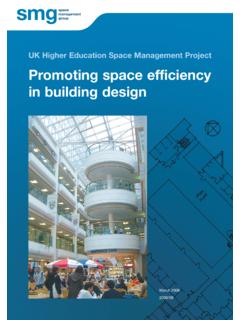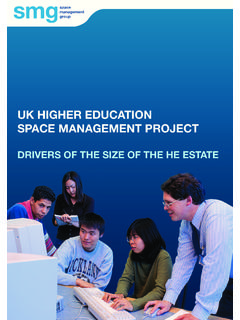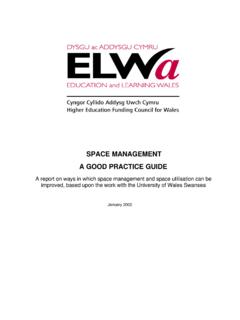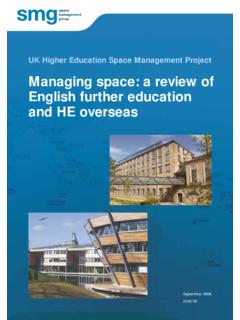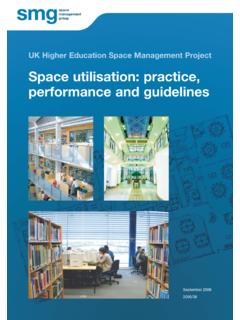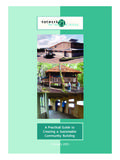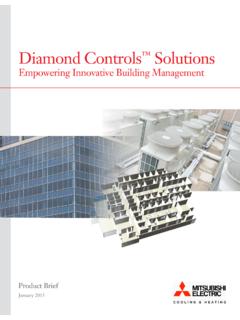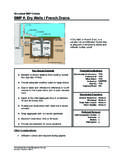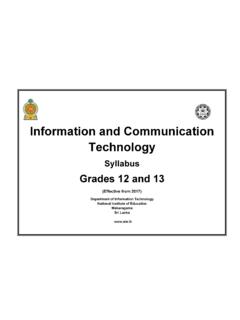Transcription of Space management project: summary - SMG
1 UK Higher Education Space management ProjectSpace management project :summarySeptember 20062006/42 Space management project : summaryContentsPagePurpose and scope of this report3 Current Space management practice4 The cost of space6 Drivers of the size of the HE estate7 The SMG model7 Impact on Space of future changes in HE8 Space management methods in other sectors9 Promoting Space efficiency in building design10 Space utilisation, performance and guidelines10 Review of Space norms11 Three case studies13 Full published reports14 Annex 1: TRAC and the SMG model of the affordable estate 16 List of abbreviations17 Space management project : summary2006/421 Purpose and scope of this report1.
2 Effective Space management in universitiesand colleges can provide measurable benefits notonly to institutional finances but also to theacademic experience of students and staff. Thissummary report, prepared by Kilner Planning,gives an overview of the work of the SpaceManagement project (SMP). The project wasunder the direction of the UK Higher EducationSpace management Group (SMG), supported bythe four UK funding bodies for higher education,the Higher Education Funding Council forEngland (HEFCE), Scottish Funding Council(SFC), Higher Education Funding Council forWales (HEFCW) and the Department forEmployment and Learning (in Northern Ireland)(DELNI).
3 2. The project aimed to develop additionalguidelines and tools to help to deliver effectivespace management . It investigated many aspectsof Space management with research being carriedout in two phases. 3. Phase One focused on three areas:a. What is current Space management practiceacross the sector? Do good practicerecommendations on Space managementmethods help to improve Space performance?b. What is the financial provision necessary foran estate to be maintained in a state that isfit for purpose and in good condition?c. What are key drivers of the size of the estate,and how can higher education institutions(HEIs) assess what size of estate isaffordable?
4 4. The findings showed that across the sectorboth full central timetabling and Space charginghave a statistically significant positive effect onspace performance. The research also led to thedevelopment of an interactive model whichenables HEIs to:a. Calculate the full annualised cost of Model and benchmark the size of Assess the impact of different estate costassumptions and carry out scenario Phase Two of the project covered thefollowing questions:a. What are the potential impacts on Space offuture changes in higher education?b. Could Space management methods used inother sectorscontribute to UK highereducation (HE) guidance?
5 C. How can Space efficiency in building designbe promoted?d. What are the guidelines for a strategicapproach to Space utilisationand how canthis Space management measure be linked tohow much and what type of Space isaffordable?e. Is it feasible to provide updated Space normsfor the sector, along the lines of the formerUniversity Grants Committee (UGC) norms?f. What can we learn fromcase studies ofindividual institutions Space managementpractice and experience?6. There are links between many of the researchareas. These are shown in Figure management project : summary2006/4237.
6 This brief report summarises the project smain findings. Full reports on the research andthe SMG model are available on the SpaceManagement Group s website Current Space managementpractice8. Eighty-four per cent of the higher educationsector (140 HEIs) responded to the first sector-wide survey of Space management practice in theUK. The survey set out to see how far publishedgood practice recommendations are beingfollowed. Sources such as the National AuditOffice stress that the key factors for successfulspace management are: leadership, objectives,information, communication and practical The survey found that some core componentsfrom published good practice are in place amonginstitutions.
7 Among the respondents:a. 70 per cent of HEIs have a spacemanagement Just over half of institutions (54 per cent)have Space management objectives or targets,and 69 per cent use performance indicatorsto manage Over 60 per cent of institutions state thatthey have the Space data needed for spacemanagement in terms of a computeriseddatabase on room sizes, capacities, functions,identification by user and number of management project : summary2006/42 Figure 1: Principal links between SMP research areasDrivers of the sizeof the HE estateCase studiesCost of a fit-for-purpose estateImpact of futurechanges in HEEffective spacemanagementReview of norms and development offramework for assessingspace needsSpace utilisationguidelinesReview of UK spacemanagement practiceReview of other Space managementmethodsSMG model for benchmarkingestate size and calculating costand affordabilityPromoting spaceefficiency inbuilding designd.
8 Almost 80 per cent of HEI respondentscollect data on Space 29 per cent of HEIs have Space 86 per cent have some computerisedcentralised timetabling, with 12 per centtimetabling all their teaching However, there are also significantconstraints on effective Space and measurable targets are rarelyfound. The link between Space managementand academic and financial planning ispatchy and inconsistent. For spacemanagement to be effective, objectives needto be linked to overall institutional resourceplanning. They need to be specific and torelate not only to general-purpose teachingspace but to specialist teaching Space ,research, office and support the management informationneeded is often dispersed within HEIs, it isdifficult both to get an overview and tohave the necessary detail for effective are gaps in data, particularly aboutroom capacities, function, identification byuser.
9 Workplaces and functional lack of functional suitability datamakes it hard for individual institutions andthe sector as a whole to assess the impact ofspace management practices on the qualityaspect of Space collected, from utilisation surveys forexample, are not always integrated into spacemanagement policy or decisions. Utilisationsurveys often concentrate on general purposeteaching Space , but this makes up only 15 per cent of the total net internal non-residential area of the HE absence of sector-wide and up-to-datespace standards or norms was repeatedlyhighlighted as a problem by some surveyrespondents.
10 Some HEIs have developedtheir own standards or norms, while 45 percent of respondents continue to use normsfrom the now-defunct University GrantsCommittee and Polytechnics and CollegesFunding Councils or Space weightings, insome cases modified by the particularinstitution. None of these norms has beenupdated since 1990, and the spacestandards underpinning them are even only provide relativities in termsof Space needs, and do not providerecommendations on areas required forspecific of Space managementguidelines and policies is sporadic, and usersare not often involved in Space managementpolicy.
